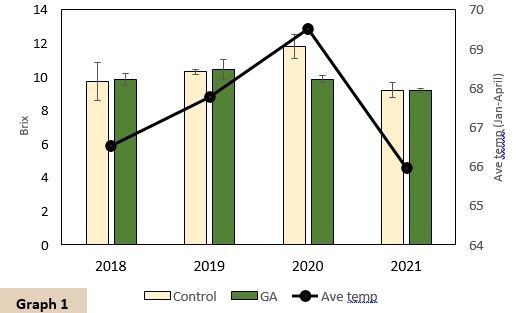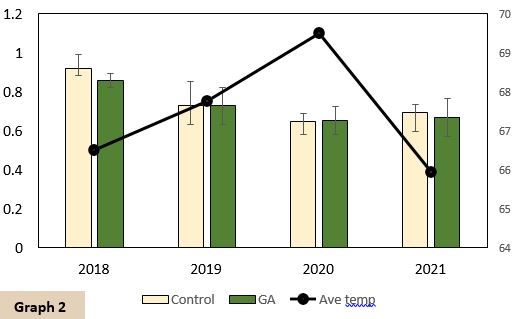- GA application slows down the fruit peel aging process and therefore requires more time to change color and develop desired Brix.
- Approximately 2-to-4-month interval between the last GA application and harvest provides sufficient time to achieve desired internal quality and peel color.
- Weather affects peel color change. Cold weather enhances color development, whereas warm temperatures can deter it. When warm weather is anticipated before harvest, GA sprays should be withdrawn sooner than later.
- GA application reduces fruit drop and improve rind quality, hence allowing the fruit to hang longer on the tree and delaying harvest. This can be a desirable scenario especially when processors and packinghouses are not accepting fruit early in the season.
- GA suppresses and synchronizes flowering, which is beneficial for the varieties that flower profusely. However, varieties that do not flower copiously should be avoided for fall GA application.
- GA affects multiple processes in the tree. Therefore, the beneficial result may not be obvious in short duration and can require up to 2–3 years of fall GA application to see improvements.

Credit: Taylor Livingston, UF/IFAS CREC
Field Trial Results
- GA-treated fruit retains green peel color for longer duration.
- No effect of GA on fruit quality if a 3-to-4-month gap is arranged between last GA application and harvest.
- Field data shows that GA-treated trees may have lower Brix if spring weather (January–April) remains warm (Graph 1).
- Hence, if the warm spring is predicted, GA sprays should be withdrawn sooner than January.
Graph Explanation
- Graph 1: Juice Brix of untreated and GA-treated ‘Valencia’ and average spring temperature. Note differences in Brix in 2020 when the spring was warmest of all years of study.
- Graph 2: Juice acid of untreated and GA-treated ‘Valencia’ and average spring temperature. GA has no effect on juice acid.

Credit: UF/IFAS

Credit: UF/IFAS